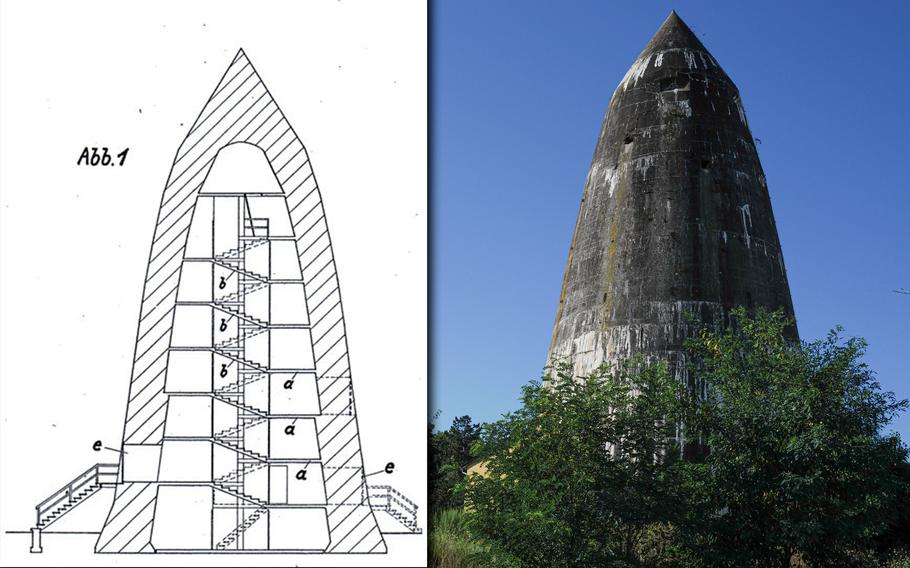
A Spitzbunker on Pariser Strasse is flanked by a supermarket and an apartment building, illustrating how Kaiserslautern's urban growth has integrated these wartime relics into the fabric of the city. The bunker, once a vital air raid shelter, now quietly coexists with the daily life of the community. (Alexander Riedel/Stars and Stripes)
If you’ve driven down Pariser Strasse in Kaiserslautern, you may have noticed two imposing conical structures standing out from their otherwise bland suburban surroundings.
These gray edifices are called Spitzbunkers. They were constructed during World War II as part of the city’s air defense system.
German residents often refer to them as “betonzigarren,” or concrete cigars. Crowned with distinctive pointed tops, the bunkers were designed by architect Leo Winkel with a specific purpose in mind.
Their unique shape was intended to make them hard to hit from the air and let bombs slide off rather than penetrate the walls.
Though Kaiserslautern was not a primary target in the early years of the war, according to wartime records, the city eventually faced significant bombings, making the bunkers vital for survival of residents and workers in the nearby railyard.
On Dec. 28, 1944, alone, American forces targeted the railway marshalling yards near the bunkers, dropping a significant payload of 536 250-pound general purpose bombs and 52 M17 500-pound incendiary cluster bombs, according to the 392nd Bomb Group Memorial Association.
Constructed in the 1940s, the two bunkers are each 82 feet high, with reinforced concrete walls over 6 feet thick and pressure-resistant doors, according to city records provided to Stars and Stripes.

A historical construction sketch shows the internal structure of a Spitzbunker, paired with a current photo of a similar bunker on Pariser Strasse in Kaiserslautern. (Graphic: Rheinland-Pfalz Technical University/Photo: Alexander Riedel)
The design of the bunkers was rigorously tested by the Luftwaffe to assess the impact of bomb blasts on human hearing by using goats, whose hearing was believed to be similar to that of humans, according to historian Michael Grube.
Goats were tied up on each floor inside the bunkers while dive bombers dropped bombs.
Since direct hits from the air were infrequent, bombs were eventually attached directly to the exterior of the bunkers and detonated remotely.
The tests revealed that most of the goats were rendered deaf, leading to the conclusion that humans should maintain a distance from the outer walls of bunkers for better protection.
Tightly packed, the structures could shelter up to 600 people each during air raids. Inside, the bunkers were equipped with basic amenities like wooden benches, electric lighting and even a ventilation system, but comfort was minimal, survivor Richard Neubrech recounted in a 2004 article in the Kaiserslauterer Wochenblatt.
While the Spitzbunkers are among the most visible remnants of World War II in Kaiserslautern, they were far from the only structures built for protection during the war.
According to local historical records, the city was fortified with numerous air raid shelters, including repurposed beer cellars and rock shelters, which played a crucial role in safeguarding civilians.
The city’s archives also detail the extensive air defense network, including anti-aircraft gun batteries positioned around Kaiserslautern and decoy sites designed to mislead enemy aircraft.
The bunkers are located on private property but have been designated protected monuments, ensuring their conservation for future generations, according to city officials.
For those interested in exploring this aspect of Kaiserslautern’s history, the city offers a guided tour called Hidden Traces of Lautern’s Brewery History.
Participants can visit underground historical shelters and learn more about their role in the city’s wartime past.
Do you have a question about life in Kaiserslautern? Ask K-Town Now today!